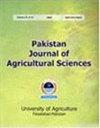Prevalence of variation among American bollworm (Helicoverpa armigera) collected from different host plant in Punjab-Pakistan
IF 0.6
4区 农林科学
Q3 AGRICULTURE, MULTIDISCIPLINARY
引用次数: 0
Abstract
American bollworm (Helicoverpa armigera) is poly-phagous pest which infects major fiber, pulses and vegetable crops, e.g., cotton, soybean, chickpea, brinjal, tomato, peas, beans, okra, and chili in Pakistan. Farmers use the different dosage of insecticides to control American bollworm on various crops that might be due to the existence of genetically diverse American bollworm population. So, it is essential to explore and get an understanding of this genetic variation existing among American bollworm, feeding on different host plants. The current study was conducted to observe the genetic variation existing among seven American bollworm populations by RAPD-PCR system collected from host plant including cotton, pea, green bean, chili, green chili, tomato and okra. Overall, 210-bands were obtained from thirty RAPD primers, out of these, 34-bands were polymorphic, and 176-bands were monomorphic. PIC values ranged from 0.2149 to 0.5014, with a mean of 0.2838. Genetic similarity ranged from 92.38% (produced by cotton and peas) to 99.52% (produced by chili and green beans) and the genetic distance range from 0.48% to 7.92%. A most important result was the clustering of the population occurring on green bean, chili, green chili, tomato and okra in one cluster. In contrast, the population occurring on cotton and pea were designated separate clusters, respectively. These results showed that population occurring on cotton and pea were most dissimilar to other populations indicating that populations are closely related to each other. There might be an interspecific crossing frequency among these populations.从巴基斯坦旁遮普邦不同寄主植物采集的美国棉铃虫(棉铃虫)的变异流行率
美国棉铃虫(Helicoverpa armigera)是一种多食性害虫,感染巴基斯坦的主要纤维、豆类和蔬菜作物,如棉花、大豆、鹰嘴豆、茄子、番茄、豌豆、豆类、秋葵和辣椒。农民在各种作物上使用不同剂量的杀虫剂来控制美国棉铃虫,这可能是由于美国棉铃虫种群的遗传多样性。因此,有必要探索和了解以不同寄主植物为食的美国棉铃虫中存在的这种遗传变异。本研究采用RAPD-PCR系统,从棉花、豌豆、绿豆、辣椒、青辣椒、番茄和秋葵等寄主植物中采集7个美国棉铃虫种群,观察其遗传变异。从30个RAPD引物中共获得210条带,其中多态带34条,单态带176条。PIC值范围为0.2149至0.5014,平均值为0.2838。遗传相似性在92.38%(棉花和豌豆生产)到99.52%(辣椒和青豆生产)之间,遗传距离在0.48%到7.92%之间。相反,棉花和豌豆上的种群分别被指定为单独的集群。这些结果表明,棉花和豌豆上的种群与其他种群最不相似,表明种群之间关系密切。这些种群之间可能存在种间杂交频率。
本文章由计算机程序翻译,如有差异,请以英文原文为准。
求助全文
约1分钟内获得全文
求助全文
来源期刊

Pakistan Journal of Agricultural Sciences
AGRICULTURE, MULTIDISCIPLINARY-
CiteScore
1.80
自引率
25.00%
发文量
18
审稿时长
6-12 weeks
期刊介绍:
Pakistan Journal of Agricultural Sciences is published in English four times a year. The journal publishes original articles on all aspects of agriculture and allied fields.
 求助内容:
求助内容: 应助结果提醒方式:
应助结果提醒方式:


